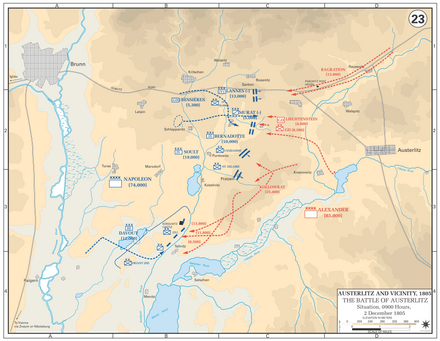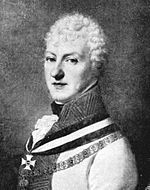Karl Wilhelm von Stutterheim
Karl Daniel Gottfried Wilhelm von Stutterheim, born 6 August 1770 – died 13 December 1811, served in the Prussian and Saxon armies during the French Revolutionary Wars, leaving the latter service in 1798.
[4] At dawn on 30 April, the Austrian Kray and Alvinczi Infantry Regiments seized the Deux-Frères (Two Brothers) redoubt atop Monte Fratelli.
With typical Austrian rigidity, the local general refused to honor the request until his superior, Ludwig von Vogelsang approved it.
[1] At the Battle of Austerlitz on 2 December 1805, he led a cavalry brigade in Michael von Kienmayer's Advance Guard column.
[10] Kienmayer put Stutterheim in charge of the two Szekler grenzer battalions, who finally captured the knoll after being thrown back twice.
The French covering force fell back to Telnice and nearby vineyards, which were vigorously defended by the 3rd Line Infantry Regiment.
Even after Kienmayer sent in Georg Symon de Carneville's three Grenz infantry battalions, the Austrians were unable to seize the village.
Carneville's grenzers, backed by the Russian 7th Jäger Regiment, stormed Telnice and drove the French beyond the stream on the west side of the village.
[13] When their leaders finally became aware of the French breakthrough of the center, the 1st Column attempted to go to the rescue, but marched in the wrong direction.
Liechtenstein with the Szekler Hussars and Stutterheim with the O'Reilly Chevau-légers plus two regiments of Cossacks covered the rear of the withdrawing 1st Column.
Buxhoeveden got away with the lead elements, but 4,000 Allies became prisoners and Dmitry Dokhturov's troops were cut off with their backs to some lakes near the southern edge of the battlefield.
Liechtenstein and Stutterheim's cavalry covered the retreat, though they suffered heavy losses from grape-shot fired the nearby enemy batteries.
[15] Stutterheim wrote La Bataille d'Austerlitz in July 1806, which was published in English as A Detailed Account of the Battle of Austerlitz in 1807.
[16] At the beginning of the War of the Fifth Coalition, Stutterheim was appointed to lead a brigade in Hannibal Sommariva's Light Division belonging to Prince Franz Seraph of Rosenberg-Orsini's IV Armeekorps.
Leading the IV Armeekorps advance guard, Stutterheim located Claude Petit's French infantry brigade in the woods at Schneidert to the east of Hausen.
[18] On 21 April at dawn, Marshal Louis-Nicolas Davout moved his III Corps east from Haugen against Rosenberg's positions to open the two-day Battle of Eckmühl.
[19] Suspecting an attack, Rosenberg put Stutterheim in command of three battalions, six squadrons, and a horse artillery battery and ordered him to hold the village of Paring, which is midway between Hausen and Eckmühl.
Meanwhile, Stutterheim's cavalry harassed the Bavarian division of Bernhard Erasmus von Deroy in its efforts to capture the town of Schierling to the west of Eckmühl.
[26] As the French and their German allies closed in on Rosenberg, Stutterheim led four squadrons of hussars in a charge which stopped the advance of some of Davout's troops near Unter-Laichling.
[29] On 29 April, Stutterheim led two cavalry regiments and a horse artillery battery from České Budějovice (Budweis) toward Linz, where he was to hold the bridge over the Danube.
[31] At the Battle of Aspern-Essling on 21 and 22 May, Stutterheim was put in charge of a light brigade in Johann Karl Peter Hennequin de Fresnel's division of Count Heinrich von Bellegarde's I Armeekorps.
While Bellegarde failed to take advantage of this enemy miscue, Stutterheim rapidly occupied the village with three battalions and began to fortify it.
[1] The author Eugen Binder-Kriegelstein considered Stutterheim and Joseph Radetzky von Radetz the only Austrian generals who showed ability in the 1809 campaign.





